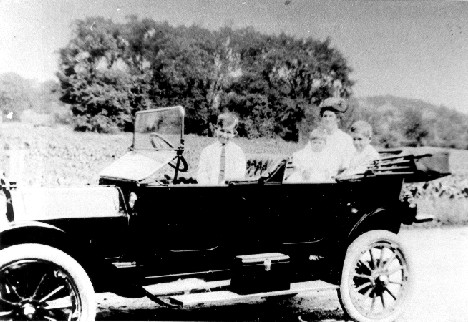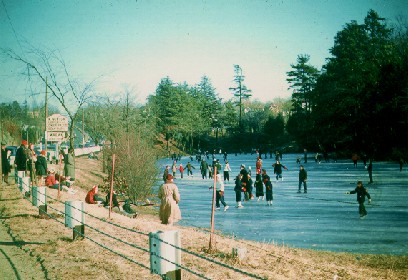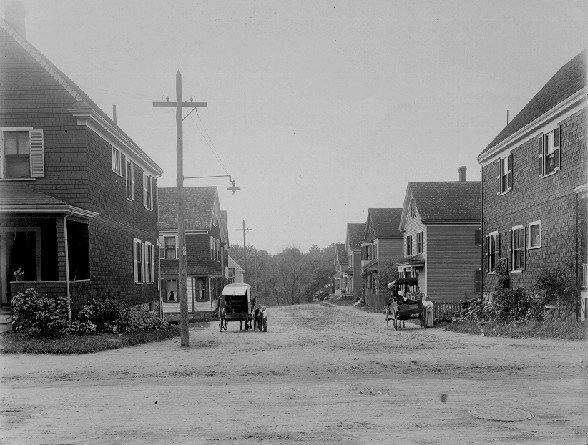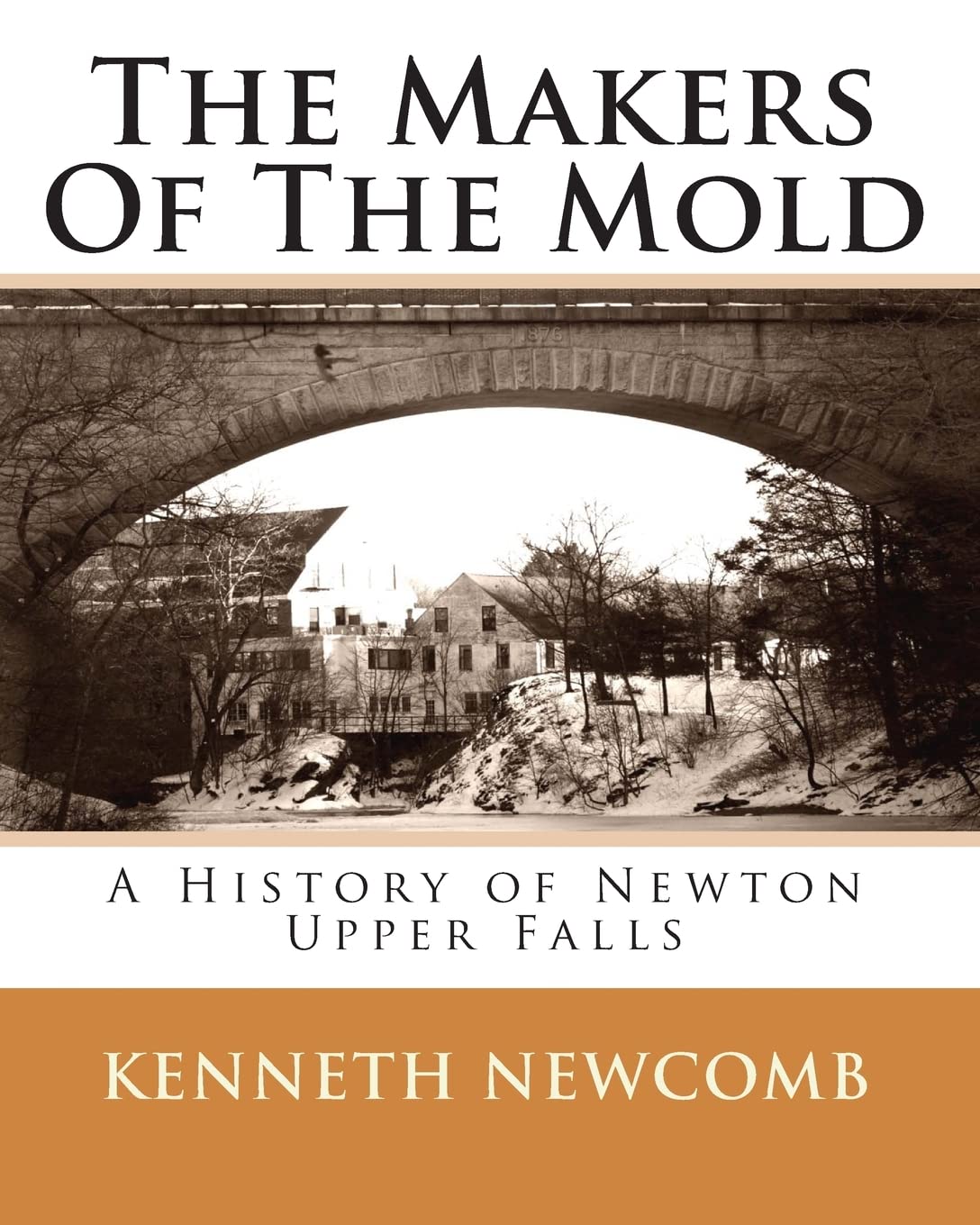The author recalls the Upper Falls of his youth.
Before we conclude this history perhaps we should stray a bit from the cold and sterile parade of historical feats and record a little of the human side of history, of everyday events of yesteryear, the memory of which we all share, whatever our age.

Upper Falls was a good place in which to grow up.
The surrounding fields with their inviting orchards gave the young room to run as well as offering a variety in their menu. The smell of roasting corn from some secluded nook or the damaging evidence of peachstones behind a meadow thicket attested to the prowess of the nocturnal pillager. There were also the groves of walnut trees and the succulent chestnuts (before the blight) which were there for the taking. The gentle hills and ledges rose just high enough to be conquered by the young explorer and give him visions in the wide dimensions of his domain, while in the nearby darkened dell and mysterious caves hid the skulking “pirates”. And through it all ran the river, not the Charles, just “the river”. Boon of the Indians, boon of the mill owners and bane of the mothers of small children, but ever the magnet whether the year be now or 1833.
John Winslow was eight that year but already the river was part of his life. This eminent lawyer shares his memories with us as we recall his remarks given at the Third Annual Reunion of the Prospect Grammar School graduates of Upper Falls in the year 1882;
“The beautiful river whose Indian name is said to have been “Quinobequin” and is said also not to have been Quinobequin, was much used by the boys, then as now, for skating in the winter and swimming in summer, and in fishing and gathering lilies. I often meet people who cannot swim. I have told some of them I learned the art in the Charles River before I was eight years old.. Sailing on the river in boats in summer and down the river on cakes of ice in winter was a pastime not to be despised in those days.
I refer now for a moment to another educational force which had full play – I mean winter coasting. Was there ever a place in all this world that supplied such facilities for that sport as good old Newton Upper Falls? I need not name the hillsides so utilized by us boys; they are round about you and you know them well. I could tell you of many a peril escaped, and some encountered, in that exhilarating sport.”
Many of our older readers have shared with John Winslow the great fun that is coasting and also, no doubt, some of its perils. The writer can recall one cold winter night in 1921 when streets were but sheets of ice, and an adventurous crew attempted the long slide on the steep and forbidding slopes of Boylston Street hill when it was a hill, criss-crossed by flat crossings of streets before it was reconstructed into its present long straight slope. At a very high speed the sled, with a crew of three, we recall, struck the left front wheel of Francis Jones’ “Chevy” on the Chestnut Street crossing. The result of the crash was a demolished sled, a broken front wheel of the car as it was spun around in the street and, fortunately, only a broken bone or two among the trio.
Many of the sleds in those days were the doublerunner type, consisting of two small handsleds bridged by a long sturdy plank, with the front end set on a pivot on the front sled for easy steering. For some reason these sleds were known as “cookies” (spelling unknown). Loaded with a half dozen people or so (not always kids) great speeds could be attained with these vehicles, and many a time several of these contested with each other in races down some of the longer slopes. Many had large gongs attached underneath the plank (some say they bore the markings of a local fire alarm company) which could be tripped by a rope held by one of the passengers. The yelling and screaming of the various crews interspersed by the loud clanging of the bells kept the community “alive”, sometimes late into the night. There was a great deal of street coasting then as traffic was not quite as heavy as at present. Lookouts at each street crossing usually kept our accident record down to just a few near misses. Later, certain streets were closed off just for coasting but that tamed the sport.
Sometime we would attach our sleds to horsedrawn sleighs, but most of the time we just “hooked” rides on them – always keeping just out of the range of the driver’s whip. One can recall that the Ryan Bros. had a fast bobsled type sleigh while Chadwick’s coal pungs were slow moving affairs, made up of a box of one ton capacity which sat low on flat steel runners. For some reason the drivers of these rigs seemed more affable than those of the fast sleighs, possibly because the pace of these pungs was so slow and draggy that the driver liked our company to help pass away the time.
Very few automobiles ventured out on the highways in the winter. Streets were not plowed (sidewalks were) but were allowed to pack for the sleighs, and as the ruts sometimes caused by these vehicles did not coincide with the distance between the wheels of the autos it made hazardous going all around for the latter. Also, cars were mostly of the open touring car type, and the side curtains which snapped together all around under the top were not tight and offered little protection against the cold.. Cars were not equipped with heaters in those days and the only warmth was provided by robes about the legs of the passengers. Also, there were no windshield wipers and the first of those that appeared later had to be hand operated.
But despite these minor handicaps, life was sweet and life was simple, especially for us kids. A youth then marked but four days or the calendar: his birthday, circus day, Fourth of July and Christmas. Oh yes, perhaps we should add a fifth, which would be “end of school” day.
Fourth of July!
Whether or not we clearly understood the significance of the day, we kids looked forward to making it a noisy one after we had observed a ritual our father faithfully performed at first light on THE DAY. In what appeared to be a hexagonal-shaped barrel of a toy cannon (but made of sturdy iron) my father would pack black powder and wads of paper, connecting this charge through a fuse hole with a fuse taken from a firecracker. Setting the cannon up against a rock in the graveled lane in front of our home, he would. light the fuse and beat a hasty retreat. We boys, in fearful anticipation, had already found shelter behind trees, telephone poles and corners of the house. The resulting blast from the little cannon (which leaped high in the air) was the Newcomb’s official salute to the celebration of Independence Day.
Cap pistols, sparklers, torpedoes, packages of firecrackers wrapped in red paper covered with those mysterious Chinese characters, and the occasional heavier two inch salute, made up the list of our noisemakers for the day; a common collection for most of our playmates in the neighborhood. There was one other noisemaker which I recall as not commonly used and which I first saw in Newton Corner when I visited. my grandparents on Emerson Street. Older boys there would secure some five gallon metal milk cans, capped with wooden bungs. They would fill the can with water and add a chemical which I believe was carbide. Previously, they had punched. a small hole in the bottom of the can near the rim. Recapping the can with the wooden bung and holding a finger over the hole, they would give the can a good shake, creating a gas formed by the combined elements. Quickly laying the can on its side and placing a foot on it to hold it down, they would apply a match or piece of smoldering “punk” to the hole. With a terrific bang the gas would explode and drive the bung half the length of Jewett Street. As I recall it now, wasn’t it the combination of carbide and water which, when lit, provided a light for our bicycles at night?
Fourth of July holidays were always special in Upper Falls with perhaps the peak of the celebrations coming in the 1920s. There was always the traditional observance of the significance of the day but this village added its own special touch, its parade of “horribles” an exuberant type of humor perhaps best expressed in the posters and signs advertising the event. Fortunately, some of these posters have been preserved, albeit in poor condition, and may be seen by courtesy of the reference desk at the main [Newton] library. Printed in heavy black ink, they measure about two by four feet and contain nothing but a delightful collection of nonsensical descriptions of things that were not going to happen on the “big day”, so far-fetched and varied that they cannot be reproduced. here – they certainly must be seen to be appreciated. The bands and floats in the parade were excellent but it was the “horribles” which the crowd turned out to see – grotesque characters designed. by the men during the year but kept secret until the day.
Following the parade there would be field events at the playground, mostly for the children . In the afternoon a baseball game would draw a large crowd but the grand finale of the day, a huge fireworks display, would attract great throngs from miles around.
Christmas!
Christmas, of course, was a quiet day by comparison and was celebrated mostly in our homes and in our churches. Would. you like to know what Christmas was like in Newton Upper Falls on Thursday, December 25, 1883? Let an unknown correspondent tell us through a newspaper item of December 29, 1883;
“Christmas day passed very quietly. The factories and shops were closed.. During the forenoon the stores and markets were open, and some of them did a thriving business. The St. Mary’s Church was the only one open for worshipers and there was a large attendance. The Methodist and Baptist churches entertained their Sabbath school children as heretofore, by having a “tree” on Christmas eve, and a merry good. time was enjoyed by the little folks. The heavy fall of snow during the past week blocked the streets, so that little driving was noticed. This Christmas-tide seems to have been one of the good. old. fashioned. kind.”
In the early days it mattered not whether fir and balsam trees (and very few spruce) grew in the area. A white pine would do as long as we could go cut it with our dad. There were one or two Christmases we can remember before the electric lights came when, for those glorious few moments on Christmas Eve, real candles twinkled brightly from the branches. And if one was small and could lie upon the floor beneath the tree, he would be rewarded forever with the memory of the dancing shadows of those long-needled branches on the white ceiling of a home that is no more.
White popcorn and red cranberries strung on string enhanced the bright green of the tree and provided most of its decoration. Gifts were not lavish in those days. A long black stocking hung near the tree would be filled with small gifts, some sweets and always the prized orange, while beneath the stocking perhaps a cast iron fire engine or some other toy, occasionally a sled.
Winter Sports

There were many places to skate in this area and it was a popular winter sport. Sheltered by high banks of trees on the south side, New Pond provided the earliest skating of the season. Before Route 128 with its Route 9 interchange was built, it was a much larger body of water and during skating season it attracted many skaters from miles around. Other ponds in the area were Dresser’s, Sharp’s, Barbour’s and Dallachies’. The last three were on the Needham side of the river and have since been filled in to make way for commercial and residential developments. And then there was the river itself, of course. As proof of the changing climate of this area, our older readers may recall when many a winter it was solidly frozen over and we could skate for miles up river. Since the big bay opposite Lucas’s boathouse was shallow, it froze over early and was a very popular place for hockey and general skating. In those days it was customary in early January for us kids to lug our Christmas trees down to the river bank to create a huge bonfire. The flames and sparks shooting high in to the air provided not only a spectacular sight but also much appreciated warmth on a cold, blustery day.
In those days skiing was more or less becoming introduced to this part of the country, and while the writer owned a pair of skis they were used mostly for just “shuffling” across country when the snow was deep. Some daredevils, however, made Jumps on the runs in Crowley’ s Valley on the Needham side, and often raced down the steep sides of the nearby aqueduct.
Tobogganing was not too popular in comparison with coasting. We can recall that there were some runs down the slopes of Marcy’s farm. The most popular sport was skating and playing hockey (or “shinny” if you prefer) . No sophisticated equipment or uniforms were required by our rank and file. No hockey stick? A curved alder branch would do, as would a tin can for a puck. Shoe skates were few and far between in those days. Most skates were of the clamp type, then later those that were tightened with a key, which when the soles of your shoes got limp and soggy from the dampness, were the devil to keep on. Often a kid would have no skates at all and we would share one of ours with him and from then on it was “hop and slide” hockey.
Kites and other Recreations
Another outlet for our free time in spring’s windy weather was kite flying. We owned none of those fancy “store boughten” kites seen occasionally today. Financial necessity demanded that we make our own and a lot of them were “beauts”, clumsily made from newspapers with long tails looking like bow ribbons on a girl’s braids. Many, unbalanced in the air, cartwheeled into tree branches and electric wires where their skeletal remains were slowly disintegrated by the elements. I can still recall, at Newton Corner I think, on a hill behind the YMCA, where more sophisticated kite flying took place and boys and adults alike, some flying box kites larger than themselves, filled the sky with their “birds”. Later, at night, candle-lit Japanese lanterns were hung on the lines. A large cardboard disk cut with a slit from its edge to the center was placed. on the line behind the lantern, causing the wind to slowly propel it upward as far as the kite. Their twinkling lights high in the sky competed with the stars and produced a pretty sight in the air.
So many of our childhood games are not played by the children of today. At one time each change of season produced its own variety. The first warm days of spring and the smell of melting tar in the road did not seem to clash with the nostalgic odor of lilacs. It was time to bring out the spinning tops and the bags of marbles, and to engage in the popping of marbles on the way to school and the many other games we played with those little globules of clay and glass; the game of “jackknife” with all the intricate ways we could devise to drive the blade into the ground.; the after-school-till-dusk games of Run-Sheep-Run, Relievo, Duck on the Rock, Buck-Buck and, of course, Baseball.
And More…
We had fun – enjoying life but sometimes made aware of death when our Saturday morning or vacation day game would be halted by the sound of the clatter of hooves and we would line up along the road, hats in hand, as a funeral cortege went by. Two spirited horses hauled each rubber-tired black hack topped by a silk-hatted, frock-coated driver proudly handling his reins from the open box seat in front. The solemnity of the long procession to St. Mary’s Cemetery would visibly impress us, except when a movement at one of the curtained windows would reveal the washed face and slicked, combed hair of one of our pals who could not resist the temptation to impress us with his importance in being involved in such a solemn, but to him, dramatic event.
However, as we stood there along that road the sound of clopping horses’ hooves were slowly being stilled all over the land as we rapidly moved into the age of the motor car. It is hard to believe that we once lived when there was not a gas station on every corner, in fact when there were no gas stations at all! One remembers that we periodically had to load up the back of our open touring car with empty ten gallon milk cans, and go down to a garage near the Newton Highlands playground (on the site of the old Scully Brothers Service Station) where there was located a small square shaped gas tank surmounted by a hand driven crank and a short piece of rubber filler hose. After much hand cranking our cans would be full, and off we would go home for one more operation to complete the transaction. An empty can, with a chamois skin stretched across its open top and held in place by clothes pins served as a filter, since all of our newly purchased gasoline had to be poured through this to remove the water and other impurities from the very low octane fuel.
In those early days when the motor vehicle laws were not as stringent as they are now, small gasoline motors were used for all sorts of locornotion. Small one wheel, one cylinder affairs were attached to a bicycle’s rear wheel which converted it into a motor cycle. One remembers also a small buckboard consisting of just slats and four bicycle wheels, powered at a rear wheel by one of these “one-lung” engines. Henry Ford’ s Model T automobiles, once made by hand, were fashioned on the first assembly lines in 1913, and reduced the price of automobiles and put the ownership of a car within the range of ordinary people. In later days, young drivers would strip off the mudguards of their second-hand jalopies and encase the tires with loose, oversize tires which would cling to the tires beneath – and give the vehicle the appearance of a racing car. Laws were soon passed, however, to ban these shenanigans.

Many of the old familiar sights and sounds have faded from our streets, such as the wagons which brought their services to your door. Fresh fish, fruit and vegetables were available. The children’s’ favorite was the ice wagon and a gift of an ice chip from the ice man was greatly prized.. Each house would display an ice card in the window with the proper price printed on its edge turned up to denote the size of the piece required.. Yes, those were the days – close your eyes and let your mouth water as you once more hear the cry of the street peddler, “Fresh mackerel” and “Fresh strawberries”!
Do you remember the old hard-rubber tire trucks that brought the oil for your old hand lamps and other items around to your door? The cans were about a foot and a half high and about four by five inches in size with corrugated sides. On top was a flat metal handle and a tapering square mouthed spout, which turned one way to prevent the oil from spilling but turned straight in order to allow the oil to flow, usually directly into the bowl reservoir of the lamp or lantern.
Yes, those were the days when many services you required came to your door – even those provided by a doctor! A salesman would come to fit you for a suit of clothes and perhaps the rest of your clothing requirements came from the mail order catalog. Those were also the days when two kinds of soap sufficed for all your cleaning and washing, white and brown; and there was only one kind of disinfectant – sulfa-napthol. Witch hazel was the only remedy for cuts and bruises while a few drops of kerosene in a spoonful of sugar cured a sore throat. Goose grease treated a chest cold and the use of an onion poultice was the best way to get rid of the croup. You ladies may recall when you inserted your curling iron into the chimney of a lighted oil lamp so that you could apply it to those unruly strands of hair And perhaps the men will remember with the writer when we used to supervise the demise of an unproductive hen in the family flock, or go down cellar and fish around in the cold clammy crock of water glass where excess eggs were stored when the hens were over productive.
There were other chores which were unpleasant, such as removing ashes from the coal stove or furnace and shaking them through a sieve to recover some of the unburned coals. We always forgot to remove the pan of water from under the ice chest before it ran all over the floor. Yet we would work just as hard filling a burlap bag with ice on a hot day and whapping it with the flat side of an ax, anticipating the delicious ice cream that would eventually emerge from the old hand cranked freezer.
There are many more of these long forgotten activities that we might mention, but think we shall stop here to allow our readers to have the fun of remembering their own.
